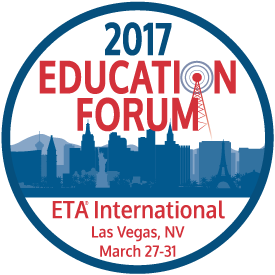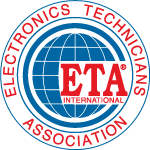
Student Scholarship Essay Contest
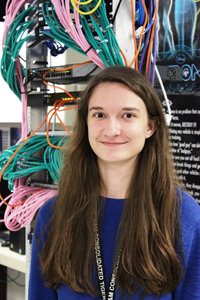
This scholarship is made available by ETA® International and International Wireless Communications Expo (IWCE). The scholarship is intended for students interested in a career in the wireless communications field. In your essay, please describe your ideal career in wireless communications. Why is this your ideal field? How will this scholarship benefit you? Why should you be considered for this scholarship?
The Scholarship Includes:
- One Short Course Package conference pass to IWCE - $549 value
- One coach class plane ticket to Las Vegas, Nevada - value up to $500
- Two nights hotel stay (room charge and tax) at IWCE’s host hotel
- Access to the Job Training & Education Center
- Access to IWCE’s two-day exhibit hall
- Dinner with ETA representatives
How to Apply:
- Submit an essay in 1,000 words (12 point type and double-spaced) or less along with a recent resume, cover letter and picture as separate attachments to mlawson@eta-i.org.
Eligibility:
- Must have at least a 2.5 GPA
- Must be a currently enrolled student
Deadline:
- January 9, 2017
Veteran Scholarship Essay Contest
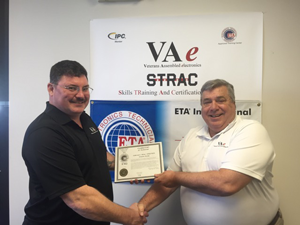
This scholarship is made available by ETA® International and International Wireless Communications Expo (IWCE). The scholarship is intended for veterans interested in a career in the wireless communications field. In your essay, please describe your ideal career in wireless communications. Why is this your ideal field? How will this scholarship benefit you? Why should you be considered for this scholarship?
The Scholarship Includes:
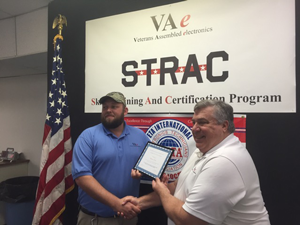
- One seat in the Radio Frequency Interference Mitigation (RFIM) hands-on training workshop conducted by IWA Technical Services, Inc., along with ETA's RFIM certification test - a $949 total value
- Five nights hotel stay (room charge and tax) at IWCE’s host hotel - $1,000 approximate value
- One Short Course Package conference pass to IWCE - $549 value
- One coach class plane ticket to Las Vegas, Nevada - value up to $500
- Access to the Job Training & Education Center along with IWCE’s two-day exhibit hall
- Recognition during ETA’s annual award banquet
How to Apply:
- Submit an essay in 1,000 words (12 point type and double-spaced) or less along with a recent resume, cover letter and picture as separate attachments to mlawson@eta-i.org.
Eligibility:
- Must have at least a 2.5 GPA
- Must be a currently enrolled student
Deadline:
- January 9, 2017
See What Others Are Saying About The Eduation Forum!
“Invaluable course material taught by Dane [Brockmiller] with an even exchange of ideas and methods from the class attendees of their past and present DAS projects. This was my 1st IWCE attendance, definitely will not be my last. I hope to see a larger female population in attendance in the coming years with the growth of the industry.”
Nicole Lloyd, Senior Telecommunication Services Specialist, University of Central Florida
“Education Forum at IWCE allowed me to learn more about DAS systems in order better understand customer needs and regulations surrounding communications indoors. Highly knowledgeable instructors provided key information on how to design and implement the most efficient system for our customers.”
Orhan Avcioglu, Business Development Manager, Telsan, Istanbul, Turkey
“My experience with ETA was great. I attended the class for the CET associate’s test. The new changes that ETA made to the class, which now focus more on the specific material that is on the test, are spot-on. This shortens the class, while still giving you the required information to do well on the test. Overall, I think it was a great success.”
Dustin Peabody, Field Technician, Creative Communications Sales & Rentals, Arizona
"The knowledge and materials provided at ETA training is invaluable in providing excellent communications that our customers depend on."
Eric Rodriguez, Technician, Highland Wireless Services, Florida
“IWCE 2015 was my first time there and it was an outstanding learning environment for anyone in the RF field. The courses offered are second to none and I suggest sending your people there!”
Martin F. Baker, Senior Telecommunications Technician, Peoples Natural Gas, Pennsylvania
Train
 ETA International is proud to host hands-on training through outside vendors in popular technology areas related to ETA certification. ETA's partners, the industry’s most respected trainers, will provide in-depth hands-on training in seven key areas of expertise beginning on Sunday, March 20. Following each training class, ETA will provide opportunities to test for ETA certification.
ETA International is proud to host hands-on training through outside vendors in popular technology areas related to ETA certification. ETA's partners, the industry’s most respected trainers, will provide in-depth hands-on training in seven key areas of expertise beginning on Sunday, March 20. Following each training class, ETA will provide opportunities to test for ETA certification.
Training courses must be registered for separately, on the ‘ETA Education Forum’ and ‘A La Carte’ tabs on the registration page. Registration for the training classes includes access to the IWCE exhibit hall, keynote addresses, general session, Party in the Park and town hall meetings.
ETA will offer ETA-approved HANDS-ON training courses leading to ETA certification with some of the industry's most respected training providers.
Associate Certified Electronics Technician (CETa)
Presented by Chris Miller, CETsr, Heartland Community College
This two-day workshop is a comprehensive two day, hands-on course that will give you all of the necessary skills in order to be successful in today's electronics industry and includes extensive hands-on training. If you are a student needing more in-depth information, a beginning technician needing expert guidance, or a practicing electronics technician wanting to enhance your skill level to advance in your career, this workshop will prepare you for success with ETA's Associate Certified Electronics Technician (CETa) certification exam.
CETa Technical Topics:
- Electrical Theory
- Electrical Components
- Soldering
- Desoldering Tools
- Block Diagrams
- Schematics
- Wiring Diagrams
- Cabling
- Power Supplies
- Test Equipment and Measurements
- Mathematics and Formulas
- Radio Communications Technology
- Safety Precautions
- Amplifiers
- Optical Electronics
- Electronic Circuits: Series and Parallel
- Interfacing of Electronics Products
- Digital Concepts and Circuitry
- Computer Electronics
- Computer Applications
- Audio and Visual Systems
- Telecommunications Basics
Wednesday-Thursday (March 29-30, 2017) - $369
Communications Site Installer (R56)
Presented by Michael Barton, CETsr, Motorola R56 Audit Team & Commdex Consulting
Based on the NEW Motorola updates of R56 industry codes and standards, this four-day workshop is for Motorola employees and affiliates only (unless invited and Motorola authorization given) that provides a documented set of standards & guidelines for designing safe and reliable communications sites helps guarantee personnel safety, equipment reliability and equipment availability. This hands-on workshop validates attendees knowledge or core concepts required in the installation of a communications site and explores all the NEW competencies recently introduced to ensure that communications sites are constructed to industry best practices and communications equipment operates in an environment that assures service reliability and longevity.
R56 Course Outline:
- Avoid Network Downtime - Lessen the likelihood of communications network downtime caused by non-compliance to R56 standards.
- Promote Workplace Safety - Ensure that sites meet the minimum standards so that site workers have a safe, working environment.
- Lower Maintenance Costs - Quickly uncover the major cause of equipment issues, lessening costs associated with troubleshooting to correct the problem.
- Comprehensive Reports and Recommendations - R56 auditor will generate a detailed report, including photos, which identifies any compliance issues and provides recommendations to get the site up to standard.
Monday-Thursday (March 27-30, 2017) - $1169 through 2/23 or $1259 late/onsite
Distributed Antenna Systems (DAS)
Presented by Dane Brockmiller, FOI, LAS, PIM, Dover Telecommunication Services
This two-day hands-on course is for technicians, managers and venue owners who need to understand the role of DAS in wireless today. This is a comprehensive hands-on course covering the six major areas of DAS, small cell, applications and deployments (noted below in detail).
Learn the latest development, installation and planning for VHF and UHF public safety DAS. Emphasis will be placed on the differences between this form of DAS and carrier-based systems along with how DAS interacts with wireless carriers and Wi-Fi. DAS coverage and component testing will be demonstrated along with plenty of hands-on exercises.
DAS and Small Cells Course Outline:
- What is a DAS
- What is a Small Cell
- The Current Role
- 4G and 5G Wireless
- VHF and UHF DAS
- Scope and First Steps
- Site Surveys
- Site or Building Planning
- Permissions – Access and Permits
- NFPA and Building Codes
- Repeaters and BDAs
- Distribution Paths
- Coupling Devices
- Coaxial Systems and Cables
- Aplifiers, Repeaters, Couplers, Splitters, and Antennas
- Coverage Requirements
- Radio Environments-Obstructions
- Mechanical Issues
- Creating Site Maps
- Use of Fiber and Coaxial Cables
- Fiber Equipment
- Donor Antennas
- Indoor Antennas
- System Configuration-Provisioning
- Antenna Line Sweep Testing
- Passive Intermodulation Testing
- Coverage Surveys
- As-Built Documentation
Monday-Tuesday (March 27-28, 2017) - $809 through 2/23 or $855 late/onsite
Fiber To The Antenna (FTTA)
Presented by Phil Shoemaker, FOI, FOT-OSP, Light Brigade
Fiber to the Antenna is intended for those who install, test and maintain fiber optic communication systems for Outside Plant FTTA installations and onsite antenna applications. Novice and experienced fiber professionals alike will find this workshop and extensive hands-on skills training beneficial for successful fiber optics careers with a practical understanding to properly install and maintain fiber optic networks. The four-day class includes 16 hours of classroom lecture combined with 16 hours of hands-on exercises.
The content focuses on the integration and installation of optical components in order to successfully establish connectivity in FTTA and cell tower applications. Attendees will participate in skills exercises that give practical hands-on experience with splicing, cable preparation, OTDR testing, and optical loss testing.
FTTA Course Outline:
- Fiber theory and terminology
- Single-mode fiber technology, including G.652D & G.657 fibers
- Multimode fiber technology, featuring OM3 & OM4 fibers
- Cleaning and inspection criteria
- Proper cable installation
- Optical loss testing procedures
- OTDR testing and troubleshooting
- Fusion and mechanical splicing
- Safety procedures
Monday-Thursday (March 27-30, 2017) - $1,665
General Communications Technician - Level 1 (GCT1)
Presented by Rob Walker, LAS, PIM, ATRG Technical Services
This certification program introduces public safety professionals and support staff to various communications concepts and technologies, including: interoperable communications solutions, LMR communications, satellite, telephone, data, and computer technologies used in incident response and planned events. This two-day workshop trains emergency responders on practices and procedures common to radio communication technicians during all-hazards emergency operations. This course will help communications technicians work within the Incident Command System (ICS) organizational structure. It is intended for federal, state, local, and tribal emergency response professionals and coordination/support personnel with communications backgrounds. Individuals who are responsible for managing a Strategic Technology Reserve (radio cache, mobile communications vehicle, or other deployable communications assets) are encouraged to attend.
GCT1 is modeled after communication systems basics and expands on the US Department of Homeland Security's Communications Technician program.
GCT1 Technical Topics:
- Basic Electronics
- Fundamentals of Radio
- Tools
- Test Equipment
- Power Systems
- Cabling and Installation
- Environmental Systems
- Antennas
- Transmission Lines
- Towers
- Operating Principles and Details on Radios and Radio Systems
- Serial Data and IP Networks
- Basics of Fiber Optic Lines and Systems
- Telephony
- Satellite Communications
- Physical Plant Considerations
- Site Procedures
- Safety Practices
Monday/Tuesday (March 27-28, 2017) - $629 through 2/23 or $719 late/onsite
Line Antenna Sweep (LAS)
Presented by Don Huston, CET, Bird Technologies
This frequency domain reflectometer hands-on course is designed for beginners as well as senior-level technicians and engineers, this course goes beyond traditional line sweep and PIM testing and provides all the knowledge in order to test and evaluate RF signals that begin at the output of a radio transmitter and eventually are propagated into the air to a receiver. Hands-on exercises will include applications of everyday problems found in the field such as: testing fundamentals, reflectometers, RF wattmeters, calibration, determining problems, distance-to-fault measurements, system sweeps, FDR operation and troubleshooting.
Technical Topics:
- Introduction to Antenna System Commissioning
- Radio Frequency (RF) Fundamentals
- Mathematics
- Coaxial Cable Fundamentals and Installations
- RF Connectors
- Antennas
- Frequency Domain Reflectometer Testing
- Operation & Test Interpretation
- Hands-on Troubleshooting
Wednesday/Thursday, March 27-28, 2017 - $809 through 2/23 or $855 late/onsite
Mobile Communications Electronics Installer (MCEI)
Presented by Chris Dalton, LAS, Radio System Analytics
This three-day workshop includes basic knowledge concepts of land mobile radio (LMR) and associated electronics equipment installation that also incorporates required hands-on training skills applicable to all of the functions required to safely and completely install mobile communications and associated electronic equipment, including removal and reinstallation. MCEI certification ensures the installer has acquired the necessary fundamental skills to deliver more safety, compliance and efficiency through the use of onboard technology.
Discussions Include:
- Mobile Installation Fundamentals
- Mechanical & Vehicle Basics
- Land Mobile Radio Fundamentals
- Basic Mobile Installation
- Post-installation Procedures
Hands-On Labs Include:
- Current, Voltage and Various Circuits within a Vehicle's Electrical System, including Fuses and Circuit Breakers
- Use of an Antenna and Cable Analyzer to Tune and Troubleshoot Mobile Antenna Installations
- Proper Drilling Practices through Sheet Metal & Carpets
Monday-Wednesday (March 27-29, 2017) - $989 through 2/23 or $1,079 late/onsite
Microwave Radio Technician (MRT)
Presented by Tom Dover, Dover Telecommunications Services
Microwave radio still plays a major role in radio and data transmission systems. Wireless carriers continue to deploy microwave systems for data backhaul, and with the advancement of LTE for public safety, the need for microwave communications continues to grow.
This two-day course is designed for students and professionals who encounter point-to-point radio at microwave frequencies. This is a comprehensive hands-on course focusing on how radio works in all applications, how digital transmission (modulation) is derived for high-speed dta, the principals of microwave frequency propagation and antenna systems. Much of this course will be devoted to hands-on testing and troubleshooting approaches for radio technicians. Federal regulators and OSHA RF safety training will also be covered.
MRT Course Outline:
- Why Microwave?
- Radio vs Fiber vs Cable
- Bandwidth, Attenuation and Noise
- Radio Regulation-FCC and NTIA
- dB and dBm
- Radio Frequency Safety Awareness
- Receivers
- Alarms
- Troubleshooting
- Maintenance
- Maxwell & Waves
- Fresnel Zone Clearance
- Wave Attenuation
- Free Space Loss & Absorption
- Ducting and Fades
- Reflections and Multi-Paths
- Types of Traffic
- T1-DS3-SONET
- Ethernet-IP Traffic
- Digital Modulation-Microwave
- Transmitters
- Antenna Gain and Bandwidth
- Directivity and Beam Width
- Antenna Types and Connectors
- Waveguide and Coax
- Antenna Testing
- Link Budget
- System Gain and Loss
- FCC and OSHA RF Safety
Monday-Tuesday (March 27-28, 2017) - $809 through 2/23 or $855 late/onsite
Radio Frequency Interference and Mitigation (RFIM)
Presented by Ira Wiesenfeld, CETsr, IWA Technical Services, Inc.
This two-day course is for anyone involved with radio services, wireless or other types of communications systems. Delivered in a concise, systematic way that will enhance your skill level, regardless of your experience, this is a comprehensive hands-on course that will give you all of the necessary skills in order to find and correct RF signal interference. The class begins with basic theory of radio and test equipment, concluding with hands-on applications of everyday problems found in the field. Designed to include beginners as well as senior level technicians and engineers, this course goes beyond interference hunting.
Discussions Include:
- Radio & Test Equipment Fundamentals
- Common and Uncommon Types of RFI
- Decibels
- Propagation Anomalies, Causes, Measurements & Cures
- Intermodulation
- Equipment
- Filters
- Antennas
- Blanking
- Capture
- Prevention
- Safety
- Other Fixes
Hands-On Exercises Include:
- Set-Up
- Calibration & Testing Fundamentals
- Locating RFI with Service Monitors & Spectrum Analyzers
- Effective Sensitivity Receiver Measurements
- Discovering Blocking/Desense Situations
- Tuning Cavity Filters
- Measuring Harmonics
- Practicing Direction Finding Techniques
- Hunting for Power Line Noise
- Applying Resolutions
Monday-Tuesday (March 27-28, 2017), $809 through 2/23 or $855 late/onsite
Learn

Each year, more than 10,000 technical professionals receive certifications from ETA's world-renowned technical certification program, in operation since 1978. Get unparalleled opportunities for professional development and continuing education credits for both ETA and IWCE courses, which will take place on Wednesday, Thursday and Friday. Attendees can participate in the entire track or mix and match ETA Short Courses with IWCE Short Courses. Short courses offer a flexible way for you to take part of the conference program while attending the exhibit hall on March 23 and 24.To attend, register for the IWCE Short Course Package.
Air Blown Fiber - Is It Just Hot Air?
Presented by Dennis Brown, Ericsson Inc.
More fiber optic cable will be installed in the US in the next couple years than in the last ten. The push for fiber to the customer premise is driving this demand. MSOs and Telecom companies are looking for the best way to beef up their fiber networks. This need has lead construction companies to find faster ways to install cable in the ground or air. The process of air blown fiber is fitting this need. This technique, used in Europe for years is now starting a buzz in the US market. Air blown fiber offers a faster and less stress delivery of fiber optic cable in a network. The special ducts used in air blown fiber can be installed in existing ducts of the network because of the smaller size of the cable and duct used in the process. How the duct is installed and the route it follows is important to get right. The proper planning will be covered to insure better installations.
Decibels
Presented by Karl Eilers
Decibels are as basic to signal level measurements as volts, amps and watts, but not nearly as widely understood. This session will demystify decibels and teach you how to roughly calculate gains, losses and levels in your head.
Ethernet in Modern Telecom, Including Service to Cell Sites
Presented by Dr. Tommy Bonner, Vivai Solutions
Ethernet has changed the entire communications world. The role Ethernet has played in communications has allowed us to expand all forms of communications. Without Ethernet the ability to transmit voice, video and data over wireless communications would be severally limited.
Fundamentals of Signal Modulation
Presented by Dr. William C. Bailey, Jr.
Advances in digital technology have revolutionized wireless communication and increased the complexity of information coding. Wireless communication systems now incorporate both analog and digital principles in ways that provide a seamless flow of information (both voice and data) between transmitter and receiver. In this session a non-mathematical overview of modulation techniques and their application will be presented. The intended audience is Communication and IT technicians that often must work with complex modulated signal, but have limited exposure or practical background in modulation theory. Topics covered will include: characteristics of analog and digital signals; analog modulation (amplitude, frequency, and phase); digital modulation (PAM, PWM, PPM, PCM, DPCM, and Delta); digital baseband and carrier modulation techniques, and digital coded signals (ASK, FSK, PSK, DPSK, M-ary and QAM signals). Those attending this session will acquire a fuller understanding of modulation techniques and their role in evolving communication systems.
IP Voting and Simulcasting
Presented by Bruce McPherson, Teltronic
This session will describe the current technology in IP-based voting and simulcasting techniques to provide wide-area land mobile radio coverage. A description of legacy systems, voting & simulcast theory, propagation, equipment, and interference considerations will be included.
Lightning and Grounding
Presented by Mark Pallans, Pallans Associates Communication Consultants
Protecting facilities from the effects of lightning requires good grounding. This session explains what causes lightning and how its effects impact facilities. Rather than telling you what to do per the standards, it explains why the standards are needed and why they were developed.
Innovative Approach Provides Robust Talent Pipeline for the Communications Industry
Presented by Tracy Ariel, Connecticut State Colleges and Universities
Connecticut has launched a statewide program to assure that high school graduates will embark on challenging, economically-productive careers. Connecticut Early College Opportunities (CT-ECO) programs are designed to prepare thousands of Connecticut students in high-skill jobs currently in technology fields, targeting at-risk and disadvantaged students. This model developed by IBM and the New York State Department of Education bridges grades 9-14 by offering high school, college and career training in one seamless educational experience, designed to meet the requirements for entry level positions in growth industries and launch students into middle careers. This innovative approach re-designs both secondary and post-secondary systems by going beyond the standard goals of college- and career-readiness- students complete a post-secondary credential, undertake assignments with partner employers, and are first in line for jobs upon graduation. This initiative serves the needs of individual students while providing a robust talent pipeline for the community and its employers.
Integration of Communications into Every Aspect of How We Run our Businesses
Presented by Douglas Hubert, University of Akron
The responsibilities of IT are shifting, workforces are diversifying and exciting things are on the way in the area of communications, enabling business processes through the use of innovations such as Application Program Interface (APIs) and Web Real Time Communications (WebRTC). The way we work is changing and the way we interact with our customers is changing, as 2016 is set to bring another wave of innovation.
RF and Laser Safety at Wireless Sites
Presented by Tom Dover, President of DTS
RF and Fiber Safety at Wireless is a 90-minute course designed for all workers who might come in contact with or be exposed to radio frequency radiation (RFR) or optical lasers used in wireless networks. This session covers four areas aimed at training the worker and general public including, who regulates this industry and potential hazards, what is the hazard, recognizing the hazard and mitigating the hazard. This is not a certification course, rather a preview of the subject and the increasing important in todays’ wireless environment. With an increase in the amount of RF energy in our environment, the importance for those installing and maintaining wireless to understand the potential dangers is growing. Most carrier and integrators require this training on an annual basis.
SDN, NFV and Fiber Optics for IOT
Presented by Raka Biswas, Ericsson Inc.
As we see in current Telecom network trends more and more traffic will pass across telco networks in 2020 than in the last 135 years added together. By the year 2020 a billion Terabytes or a Zettabyte of traffic will be sent over the telco network. This immense increase in traffic is due to increased use of smartphones, connected devices, and the use of mobile broadband with many services that are hosted on the IP networks. Operators are looking for ways to increase capacity, coverage and at same time ensure that their business KPIs are met. Traditional network architectures are ill-suited to meet the requirements of today’s enterprises, carriers, and end users. The future of connected society is Internet of Things (IOT). The ICT industry in general, sees Software Defined Networking (SDN) and Network Function Virtualization (NFV) as a key new technologies for realizing the attributes of IOT. With Internet of Things not only that we need to do the networking differently or virtualize the network to scale network function better but at the same time we need greater physical capacity in the backhaul to transport high amount of data. With advanced technologies in Fiber network this mission will be realized.
Why is PIM Testing Important? Why Are so Few Doing It?
Presented by Tom Dover, President of DTS
Passive Intermodulation (PIM) has been with us since the beginning of radio; so why is it now important? Simply put the answer is NOISE! Radio noise often called the noise floor puts ear muffs on radio receivers reducing their ability to capture small signal levels. With the rapid move to LTE and other data rich wireless applications the impact of noise has received a great deal of attention. This presentation will provide a short overview of why PIM at long last is getting its due attention. The primary sources of PIM, along with a detailed discussion of internal vs. external PIM will be defined. How we can test for it in all radio bands? More importantly, how can it be mitigated? Time will be allocated for questions from the audience specific to problems found at radio sites.
Keynote Address
Optical Fiber Technology – Providing the Solution for 1 Tb/s Transmission
 The evolution of fiber optic communications and optical fiber technology is accelerating with no slowdown in sight. In recent years, we have seen tremendous jumps from 40 Gb/s data rates to field trials of Terabit levels. Fiber optics is the backbone of the communications age and without it, the Internet would not link today’s users worldwide. From Fiber to the Home to high speed data centers to long haul telecommunications infrastructure, fiber optics is being deployed to fulfill the worldwide communications appetite for bandwidth.
The evolution of fiber optic communications and optical fiber technology is accelerating with no slowdown in sight. In recent years, we have seen tremendous jumps from 40 Gb/s data rates to field trials of Terabit levels. Fiber optics is the backbone of the communications age and without it, the Internet would not link today’s users worldwide. From Fiber to the Home to high speed data centers to long haul telecommunications infrastructure, fiber optics is being deployed to fulfill the worldwide communications appetite for bandwidth.
Challenges ahead include an evolving technology, including advanced modulation formats, coherent detection and forward error correction, but also the role of technicians will expand to address changing technologies and fiber optic technologies.
About the Speaker:
Larry Johnson, Director and Founder of Light Brigade, has been at the forefront of the fiber optics industry since 1977. Over his three-plus-decade career in the telecommunications industries, Mr. Johnson has built a solid reputation in all aspects of fiber optic design, installation, implementation, testing, and measurement. Identified as an luminary of the Fiber Optics industry in 2000 he has participated in the early development of fiber optic standards used for installation, testing, and measurement of network and physical plant. His leadership in the optical fiber industry has resulted in repeated invitations to speak at key conferences worldwide, and to develop fiber optic certification programs for a variety of industries. One of his hobbies is to archive the history of fiber optics and has been fortunate to know most of the inventors of the fiber optic revolution.
About Light Brigade:
The Light Brigade, AFL's education and training division, provides fiber optic training and certification, including hands-on courses, instructional DVDs, books, and online training as well as customized fiber optic training materials for specific industries or subject matter. Over the past quarter century we have trained tens of thousands of individuals, giving them the skills they need to move forward in their careers.
Our instructors are technically skilled and have a wide variety of practical experience with fiber optic systems. Many have taught collegiate-level courses in electronics and telecommunications while others have built and operated fiber-optic networks or served as consultants for international companies. Light Brigade instructors constantly evaluate new products and learn new techniques to maintain leading-edge awareness in numerous industries. Our courses are continually updated with the latest standards, equipment and best safety practices to ensure our students have the latest knowledge in their field.
Special Events
ETA’s Annual Membership Meeting
Membership in ETA’s professional association provides meaningful growth, resulting from the added value members receive through professional development and involvement with other members. One of the privileges of membership in ETA International is your right to voice your opinion about the direction of ETA and to learn how it has served its members in the previous year.
Join ETA Tuesday, March 28, 2017 at 5:00 pm in the Las Vegas Convention Center for the annual membership meeting.
ETA’s Awards Banquet
Join ETA at the Annual Awards & Officer Installation Banquet to recognize the contributions of outstanding individuals to their industry and induct the newly-elected ETA 2017/2018 Board of Directors.
You are invited as ETA's guest to the Italian American Club for a traditional Italian buffet. Larry Johnson, Director and Founder of Light Brigade, will give the keynote address about fiber optics communication. Then stay for musical entertainment in the lounge. Limited shuttle service will be provided.
Join ETA Thursday, March 30 at 6:00 pm at the Italian American Club.Other special events include Town Hall meetings and Party in the Park. These are open to all badged attendees.

